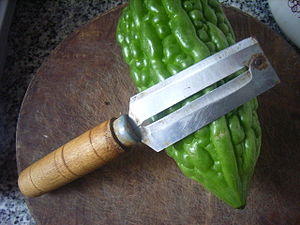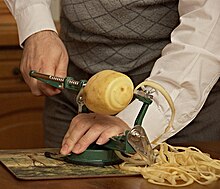
A utility knife is any type of knife used for general manual work purposes. Such knives were originally fixed-blade knives with durable cutting edges suitable for rough work such as cutting cordage, cutting/scraping hides, butchering animals, cleaning fish scales, reshaping timber, and other tasks. Craft knives are small utility knives used as precision-oriented tools for finer, more delicate tasks such as carving and papercutting.

A knife is a tool or weapon with a cutting edge or blade, usually attached to a handle or hilt. One of the earliest tools used by humanity, knives appeared at least 2.5 million years ago, as evidenced by the Oldowan tools. Originally made of wood, bone, and stone, over the centuries, in step with improvements in both metallurgy and manufacturing, knife blades have been made from copper, bronze, iron, steel, ceramic, and titanium. Most modern knives have either fixed or folding blades; blade patterns and styles vary by maker and country of origin.

The hilt is the handle of a knife, dagger, sword, or bayonet, consisting of a guard, grip, and pommel. The guard may contain a crossguard or quillons. A tassel or sword knot may be attached to the guard or pommel.

The kukri or khukuri is a type of short sword with a distinct recurve in its blade that originated in the Indian subcontinent. It serves multiple purposes as a melee weapon and also as a regular cutting tool throughout most of South Asia. The kukri, khukri, and kukkri spellings are of Indian English origin, with the original Nepalese English spelling being khukuri.

A blade is the sharp, cutting portion of a tool, weapon, or machine, specifically designed to puncture, chop, slice, or scrape surfaces or materials. Blades are typically made from materials that are harder than those they are intended to cut. This includes early examples made from flaked stones like flint or obsidian, evolving through the ages into metal forms like copper, bronze, and iron, and culminating in modern versions made from steel or ceramics. Serving as one of humanity's oldest tools, blades continue to have wide-ranging applications, including in combat, cooking, and various other everyday and specialized tasks.

A Japanese kitchen knife is a type of kitchen knife used for food preparation. These knives come in many different varieties and are often made using traditional Japanese blacksmithing techniques. They can be made from stainless steel, or hagane, which is the same kind of steel used to make Japanese swords. Most knives are referred to as hōchō or the variation -bōchō in compound words but can have other names including -kiri. There are four general categories used to distinguish the Japanese knife designs: handle, blade grind, steel, and construction.

The Opinel company has manufactured and marketed a line of eponymous wooden-handled knives since 1890 from its headquarters in Saint-Jean-de-Maurienne, Savoie, France where the family-run company also operates a museum dedicated to its knives. The company sells approximately 15 million knives annually. Opinel knives are made of both high carbon and stainless steel, the latter being Sandvik steel from Sweden.

A kitchen knife is any knife that is intended to be used in food preparation. While much of this work can be accomplished with a few general-purpose knives – notably a large chef's knife, a tough cleaver, a small paring knife and some sort of serrated blade – there are also many specialized knives that are designed for specific tasks. Kitchen knives can be made from several different materials.
In cooking, a chef's knife, also known as a cook's knife, is a cutting tool used in food preparation. The chef's knife was originally designed primarily to slice and disjoint large cuts of beef. Today it is the primary general-utility knife for most Western cooks.

A straight razor is a razor with a blade that can fold into its handle. They are also called open razors and cut-throat razors. The predecessors of the modern straight razors include bronze razors, with cutting edges and fixed handles, produced by craftsmen from Ancient Egypt during the New Kingdom. Solid gold and copper razors were also found in Ancient Egyptian tombs dating back to the 4th millennium BC.
WÜSTHOF is a knife-maker based in Solingen, Germany. Family owned for seven generations, the company's main products are mid-priced to high-end kitchen knives for domestic and professional use. WÜSTHOF is one of the leading manufacturers of chef's knives.

Gerber Legendary Blades is an American maker of knives, multitools, and other tools for outdoors and military headquartered in Portland, Oregon. Gerber is owned by the Finnish outdoors products company Fiskars. Gerber was established in 1939 by Pete Gerber.

Sharpening is the process of creating or refining the edge joining two non-coplanar faces into a converging apex, thereby creating an edge of appropriate shape on a tool or implement designed for cutting. Sharpening is done by removing material on an implement with an abrasive substance harder than the material of the implement, followed sometimes by processes to polish/hone the sharp surface to increase smoothness.

Dha is the Burmese word for "knife" and "sword" similar term to daab or darb in Thai language for a single edge sword. The term dha is conventionally used to refer to a wide variety of knives and swords used by many people across Southeast Asia, especially present-day Myanmar (Burma), Thailand, Yunnan, Laos, and Cambodia.

Knife sharpening is the process of making a knife or similar tool sharp by grinding against a hard, rough surface, typically a stone, or a flexible surface with hard particles, such as sandpaper. Additionally, a leather razor strop, or strop, is often used to straighten and polish an edge.

A kitchen scraper is a kitchen implement made of metal, plastics, wood, rubber or silicone rubber. In practice, one type of scraper is often interchanged with another or with a spatula for some of the various uses.
Chris Reeve Knives is an American knife manufacturing corporation with international sales and distribution headquartered in Boise, Idaho, that designs, develops, and sells folding pocket knives and fixed-blade knives. Its products include the Sebenza, Inkosi, Umnumzaan, TiLock, Mnandi folding knives, Impinda slip joint, and the Green Beret, Pacific, Professional Soldier, Nyala, and Sikayo fixed blade knives. Chris Reeve Knives' industry contributions include the Integral Lock, contributions to the blade steels CPM-S30V and CPM-S35VN, and has won Blade Magazine's Blade Show Manufacturing Quality Award 15 times. Their motto is Think Twice, Cut Once.

Spiral vegetable slicers are kitchen appliances used for cutting vegetables, such as zucchinis, potatoes, cucumbers, carrots, apples, parsnips, and beetroots, into linguine-like strands which can be used as an alternative to pasta.

A Chinese chef's knife — sometimes referred to as a Càidāo, a Chinese cleaver or a "chopper", is the rectangular-bladed, all-purpose cooking knife traditionally used in China, Vietnam, Cambodia and many other Asian countries to prepare a variety of meats, fish and vegetables. The popularity of this style of knife has spread with the associated cuisines. They resemble Western cleavers in appearance, but most Chinese chef's knives are relatively thin-bladed and designed for slicing, finely chopping and mincing vegetables, fish and boneless meats. The heavier gǔdāo are produced and are used much like Western-type meat cleavers to prepare large sides of beef, pork and other boned meats. However, Chinese-style knives of this weight are not common in the West.
























